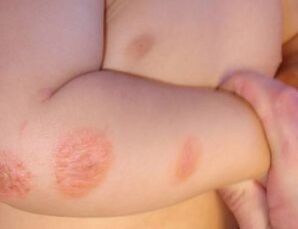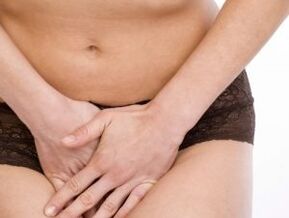
Timely detection of the disease is the key to successful treatment. This rule is especially true for diseases that are very difficult to treat. These include lichen psoriasis, also known as psoriasis. Over the past decades, the disease increasingly covers many territories, affecting infants and retirees, tilting statistics in a sad direction.
It's not in vain that the scaly lichen has caused such serious concern. Today, psoriasis has shifted from a classification of common skin diseases to systemic diseases. It has been shown that patients with this disease are more susceptible to infections, heart disease, depression and diabetes. Due to the lack of a uniform treatment system, the identification of psoriasis in its initial stage is very important.
The first signs of psoriasis
These dermatological symptoms are identifiable even for people who have never faced the same problem. A common sign of lichen scab is a patchy skin rash.
This rash appears in the inflamed epidermal areas, it can be large or cloudy, scaly and sometimes purulent. Each individual element of such a rash is called a papule. Observations of patients with psoriasis show that the disease may appear the first signs even before the appearance of papules on the body.
In most cases, the appearance of a rash is pre-mood swings, loss of appetite and indigestion. It has been found that the depressive state, often for no reason, very often appears a few days before the first papules form. The problem is that patients with similar symptoms have no reason to see them. But, even in the case of timely examination to the doctor, a specialist is far from being able to determine the true cause of the condition and make an accurate diagnosis.
A rash on the body is the main symptom of psoriasis. Depending on the type of scaly lichen (and there are dozens of types), the location of the lesion, the patient's age, the disease may manifest itself in different ways.
Child manifestation

Scaly lichen can even occur in babies. This is very rare, but is often exacerbated by the parents themselves. The early signs of the disease may look like a rash or allergy, so adults should rely on their knowledge to self-treat the child. In most cases, infants with psoriasis see a doctor when the disease has transitioned to a severe stage.
In infants, scaly lichen usually appears in folds: on the inner thighs, armpits, between the toes and hands, in the folds of the skin on the neck. When papules appear, they are often accompanied by itching, so the baby is very restless, does not sleep at night, and refuses to eat.
The affected area looks like a thrush, a diaper rash or eczema. The inflamed skin becomes red or pink and hot to the touch. Pustules may appear in waves or form a spot - plaque. As a rule, such spots will pop out on healthy skin areas. The prominent feature of psoriatic plaques is that the rash is dry, scaly and scaly, but in young children these papules and plaques are often located in areas that produce a lot of sweat, making the surface of the inflamed les wet.
When these symptoms are present, it is important that you do not spend time on folk remedies and tips from ancient times. If the infant develops a rash (of any kind), he or she should be taken immediately to a pediatrician and a dermatologist. Treatment of psoriasis in infants is not much different from adult therapy, children are given non-hormonal therapy ointments, in severe cases, pills and injections.
In older children, the early symptoms of lichen scab will be the same as that of adults. However, children can suffer from any type of psoriasis:
- Plaque- happens most often. Its signs are dry, red, hot nodules. The nodules are covered with a hard crust with pale scales on the surface. They can appear anywhere, clockwise or merge into arrays. It itchs most often, but not necessarily.
- Pustules- characterized by the presence of fluid or pus inside the papules. The initial stage looks like a plaque: the papules have a clear margin, protruding from the epidermis but filled with fluid.
- A hairy head- may look like dandruff, but over time will form a very flaky, scaly layer over the entire surface or part of the head. Hair in the affected area is thinner, thinning. This type of psoriasis usually appears in the folds behind the ear.
- Palmar-plantar- almost never happens in children. The difference is localized on the palms of the hands and soles of the feet, while "lakes" with rough and scaly skin appear.
- Curved surfaces- usually formed on the elbows, knees, genitals. It differs from other types of psoriasis in that it is not scaly. The affected skin becomes covered with a smooth and firm crust, like a single speck emerging on the surface of a healthy epidermis. Colors - light pink, white gray, pink.

For any local peeling and inflammation on the skin, you should consult a dermatologist. Psoriasis in children progresses very quickly, especially if it is accompanied by itching.
Damaged papules are very susceptible to superinfection, growing and covering an increasingly large area. After having a prescribed treatment regimen, it is important to regularly monitor the child, avoid scratching the wounds and new wounds on the body, and follow the diet.
Female expression
The early stages of psoriasis can manifest themselves at any age, but often the first outbreaks occur before the age of 20, although the disease can "sleep quietly" even up to 50 years. Adult men and women experience the same symptoms as teenagers. In more adulthood, the risk of psoriasis on the soles of the feet, nails, and joints increases.
World disease statistics show that women with lichen have scabs almost once and a half times more often, while the main proportion is struggling with plaque psoriasis. It is not known exactly what caused this selection, but scientists suggest a hormonal factor among the causes of psoriasis.
Due to the same hormonal sharing, signs of lichen scaly in girls are most likely to appear in premenstrual syndrome, when the hormonal background changes. In addition, a woman's natural sensitivities make them susceptible to stress, depression, and neurological disorders. For a person at risk for psoriasis, any psychological instability can trigger an outbreak.
Other causes of an exacerbation are:
- skin lesions (burns, cuts, open wounds);
- allergic reactions;
- infectious diseases; metabolic disorders
- ;
- bad habits and unhealthy diet.
In fact, if a woman has a genetic predisposition to psoriasis, one of the factors that provokes sooner or later will trigger an outbreak. To avoid such exacerbations in the future, the patient must carefully monitor his or her lifestyle.

The symptoms of psoriasis are the same in women as in men, the only gender difference appears when the external genitals are affected. On the genitals, girls have to face with genital warts and ingrowns, sometimes with pustules. The first symptoms are dermatitis on the labia or pubic lips, rarely the mucous membrane is affected.
Small papules like pin heads can appear in clusters or a single array. Genital psoriasis rarely appears, since the localized site does not allow air entry. A prominent feature of a psoriatic rash is a slightly protruding papules and patches on the surface and hot. With such manifestations, you should immediately contact a dermatologist, gynecologist.
Manifestations
Half of men, as we have noted, usually have slightly less scaly lichen disease than women. However, the course of the disease and symptoms remained the same for both halves. A survey and analysis of patients showed that in men the first symptoms appear between the ages of 22 and 25, while in women this symptom appears from the age of 15 years. Such "late" symptoms are related to the fact that the hormonal balance in the stronger half comes later.
Psoriasis begins in men in a similar way. In most cases, small papules with silver scales appear first, then merge into large spots - plaques and "paraffin lakes".
Intestinal psoriasis affects large areas of the body at once, but with separate small joints.
You can also differentiate psoriasis from other skin conditions at home, if you carefully examine the inflammatory factors:
- A thick, coarse crust that forms on the surface of papules and plaques that flake off. The white on the surface flakes off easily when scraped, like shavings.
- If you completely remove the scab from the papilloma, a thin transparent film will remain on it.
- When the membrane is removed from the psoriatic part, large drops of blood will appear in this area, as there are many capillaries in the papules.

In addition to obvious symptoms, scaly lichen is sometimes accompanied by general weakness of the body, depression and increased body temperature. Psoriasis elements can have different shapes, for example, individual papules in small numbers that appear with a spot lesion. Infection of a large area of the body at once (entire back, sides, abdomen, legs) occurs with teardrop-shaped psoriasis, while a tear-shaped papule. Localized large plaques are a sign of coinfection psoriasis.
Based on the observations of patients of both sexes, the scientists concluded that in men, lichen scaly worsens, and occurs more frequently in women. Reviews of experts note that this is due to the lack of wanting to be treated trivial. However, the other half is more concerned with their health and goes to the doctor for preventive treatment much more often than the male. The only type of psoriasis that men do not hesitate to treat is genital disease. A type of plaque-like, ingrown, or pus-like plaque that can appear on the glans penis, scrotum, or pubic.
Due to the sensitivity of the skin in these areas, the inflammation progresses rapidly and requires immediate treatment. When it comes to any itchy genital rashes, it is not advisable to spend time “doing self-exam” and self-medication. Even if the skin is very flaky, redness and itchy inflammation is considered a reason to see a doctor.
Nail psoriasis (nail dystrophy) and scalp disease in men are also common. According to dermatologists, these two types are most often launched by men. Despite the fact that there are many pictures on the Internet with signs of the disease, the symptoms of scaly lichen are said to be fungus or dandruff, and they go to the doctor with the form that has progressed.
In the case of a damaged scalp, severe desquamation occurs, sometimes causing itching, rough scabs in locations or on the entire scalp surface. Nail psoriasis is manifested by a change in nail color, the appearance of dents and bumps, and compression of the nail and surrounding skin. We'll look at the hierarchy of symptoms in more detail below.
So in children, women and men, the symptoms of psoriasis do not differ. Any inflammation on the body's skin, head or nails is a reason to see a doctor. If the affected area does not itch or flake, this does not mean that the skin is not affected by psoriasis.
Psoriasis symptoms
The first signs of illness usually last for a few days, after which they begin to progress rapidly. Sometimes the disease can develop very slowly and symptoms initially "delay" for a week or more. In any case, the disease will enter the full-blown stage, sooner or later. The localized sites of psoriasis are often misleading to the patient and the specialist themselves. Nail psoriasis that is similar in the first manifestation is difficult to distinguish from a common fungal infection.
Scalp expression

In the early stages of development, psoriasis on the scalp looks like a slight flaking. Gradually, the affected areas become reddish in color, they can be painful and itchy, sometimes protruding from the hairline: behind the head, behind the ears, on the forehead. The epidermis in the inflamed areas becomes denser, the dense structure of the psoriatic rash is considered one of the distinguishing features.
This is often confused with seborrhea, in which the scalp also flakes a lot. However, unlike seborrhea, psoriatic factors bleed if the upper scaly layer is removed from them. In addition, psoriasis is characterized by the roughness of the affected skin area. If this rash is accompanied by severe itching, the patient often aggravates the situation with traumatic plaques and papules. The open wound quickly becomes infected and the disease gets worse.
This scaly lichen occurs in children and adults. Self-medication usually only worsens the picture of the disease, so when you suspect psoriasis for the first time, it is better to consult a specialist. Trichologists and dermatologists can precisely understand the nature of the inflammation, and it is better to take the child to see a top specialist.
Body skin manifestation
On the body, the first papules usually appear where there are folds and rubs: on the knees, armpits, elbows, neck. Depending on the type of psoriasis, the manifestations can be different. For children, adults can experience many of these diseases, but a few more points are added to the list above.
In addition to the most common types of scaly lichen, people over the age of 18 may encounter:
- Pustules,did not differ in symptoms in adults and children. It affects any part of the body and is characterized by a serious process. Often accompanied by fever and general weakness. The papules are first filled with clear fluid, which helps to distinguish this disease from the rest. If they are damaged and re-infected, pus will appear in them.
- Psoriasis blood skin.This is considered to be a very complex form of the disease, most of which do not appear immediately, but progress from plaque or pustules. But an independent course is also possible. Unlike conventional psoriasis, this disease affects large areas of the body and develops very quickly. The papillae may be "hollow" or filled with pus. If the psoriatic element becomes damaged and grows at a high rate affecting large areas of the body, it is most likely erythema.
- Droplet-shaped,, as we have learned, is characterized by frequent wounds and skin lesions. At the onset of the disease, the nodules are very small, have a clear bank, and are concave, drip-shaped. At first, it affects small areas of the body, but gradually develops. May appear on arms, legs, abdomen, back, neck.
- Psoriasis of the joints.The worst that can happen with this disease is damage to the joints. This usually occurs in people who are already sick with one of the different types of psoriasis, but it can also appear as an independent disease. At first, it affects small joints: the toe and hand joints, often moving to more important positions. The first signs for him are pain and soreness in the joints, fever, swelling of the fingers.

Arthritis psoriasis and erythrocyte psoriasis are considered particularly dangerous, as they cause more serious complications. Where the joint is damaged, the disease threatens to be truly disabled. However, the most severe forms of the disease usually appear in patients who already have psoriasis.
Expression at foot
The most commonly affected leg is in the knee area, it can be inverted psoriasis or plaque. In this case, the knee is completely or partially covered by a dense crust with a rough white surface. Often times, with knee defeats, the same goes for the elbow, but not necessarily. We have learned to identify psoriasis with papules.
Also, legs are a common teardrop-shaped lesion. In this case, most of the leg is covered with small papules, while also occupying an area from the lower legs to the thighs. Factors are inflamed, hot, sometimes itchy and painful.
Rough skin, painful itchy calluses on the feet are signs of vegetative psoriasis and it can also "touch" the palms at the same time. This is a very common form of the disease, because the feet are most susceptible to mechanical damage. The skin at the site of the lesion is cracked, scaly, itchy. It is important to seek prompt advice, as fungus and infection can get into the cracks, causing serious complications.
Nail manifestation
Nail dystrophy affects the nails. It often accompanies other, more complex forms of psoriasis, but sometimes it appears on its own. With such a disease, patients often come to the clinic very late, mistaking this disease for fungus. The symptoms of the disease are:
- changes the shape of the nail;
- protrusions and nodules on the nail plate;
- change in nail color (light brown, cloudy, with dark spots);
- rough skin under and around the nail;
- overgrowth of skin on the nail;
- peels the nail both vertically and on the plate.
Treatment of this disease doesn't take time either. Progressing slowly but steadily, as a result, the patient may completely lose the nail without further recovery. For advice in this case, you also need to contact a dermatologist.
Hand expression
Psoriasis affects the arm as often as the rest of the body. Most often, under his "line of sight" is the elbow, as he is most susceptible to friction, bending, and injury. In this area, pustular, plaque, reversible psoriasis is localized. In this case, the first signs of the disease develop like the knee.
A very problematic area on the arm is located in the armpit. Any kind of disease progresses very quickly here, as it is a warm and humid place, with no good air. In this case, the psoriasis is not always covered with a flaky flake of scabs, plaques and pustules that may resemble a normal irritation or a diaper rash.
If inflamed spots develop and multiply - consult a dermatologist urgently.
Manifestation of the disease in case of joint damage
As noted, the small joints of the fingers and toes are most commonly affected in psoriatic arthritis. In a difficult development, this disease affects the spine and pelvic joints. It is very difficult to recognize the disease in the early stages, especially at home. Unfortunately, diagnosis is very difficult. Today, even clinics can only determine the consequences of joint damage, not prevent disease.
In most cases, arthritis psoriasis is a complication of another form of the disease and rarely acts as an independent disease. One distinctive feature is that it affects the connective tissue around the joint. For example, if the joints of the finger are affected, the patient will develop arthritis - an inflammation of all the tissues in the finger. At the same time, they increase volume, do not bend, much pain.
Conclusion
Nowadays there is no psoriasis treatment system, nor a single drug that can help every patient with this disease equally effectively. Scaly lichen is classified as a systemic, non-infectious disease that occurs in a chronic form. Cannot be cured once and for all, but there is a complete possibility of long-term remission. Early detection of the disease greatly simplifies this task.
As a precaution, doctors recommend a checkup and tests for six months or a year, even if there is no suspicion of illness. With persistent red, itchy rash, peeling many areas of the skin, you should immediately contact a specialist, do not waste valuable time on buying very dangerous oral medicine.























